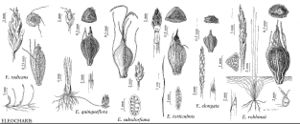Eleocharis suksdorfiana
Bull. Soc. Bot. Genève 13: 267. 1922.
Plants perennial; rhizomes 0.5–1.5 mm thick, scales persistent, 5–10 mm, thinly membranous, not fibrous; resting buds absent (non-resting buds on rhizome apex ellipsoid, 10 × 2–5 mm); caudices present, hard, 2 mm thick. Culms erect, not spirally twisted, not contracted near spikelet, when dry usually with several blunt to acute ridges and sulcate, subterete to slightly compressed, to 2 times as wide as thick, (5–)10–40 cm × 0.5–1.2 mm, firm to hard, finely many-ridged at 10–20X; culm tufts not proximally bulbous. Leaves: distal leaf sheaths stramineous to brown or reddish proximally, green to stramineous distally, subtruncate to obtuse, membranous to papery; apex brown to red. Spikelets 5–10 × 2–4 mm; proximal scale usually empty, 3–5 mm, usually 1/2 or more as long as spikelet; floral scales 8–12 per spikelet, lanceolate (to ovate), 3.5–5 × 2–2.5 mm. Flowers: perianth bristles 6, equal, the longest equaling achene to exceeding tubercle, very slender, spinules dense; anthers 1.6–3.5 mm. Achenes medium brown to gray or dark brown, equilaterally trigonous to compressed trigonous, rarely some biconvex, 2–2.7 × 0.7–1.3 mm, apex tapered to a distinct stramineous beak 0.2–0.9 × 0.3–0.6 mm. Tubercles 0.4–0.5 × 0.3–0.5 mm.
Phenology: Fruiting late spring–summer.
Habitat: Bogs, fens, wet meadows, springs, wet gravel near ponds
Elevation: (0–)1100–3300 m
Distribution

Alta., B.C., Calif., Colo., Idaho, Mont., Nev., Oreg., Utah, Wash.
Discussion
Although Eleocharis suksdorfiana is usually included in E. quinqueflora, it clearly differs qualitatively as given in the key. A collection from hot springs in Ruby Valley, Elko County, Nevada, has stout perianth bristles less than half of the achene length and may represent an undescribed taxon related to E. suksdorfiana. Eleocharis suksdorfiana closely resembles E. rostellata in its achenes, tubercles, culms, and caudices; it differs in the presence of long horizontal rhizomes and the absence of stoloniferous culms. The achenes of E. suksdorfiana are often finely longitudinally ridged, but in E. rostellata they are often rugulose. Specimens from Coconino and Santa Cruz counties, Arizona, are probably E. suksdorfiana but lack achenes so cannot be identified with certainty.
Selected References
None.
